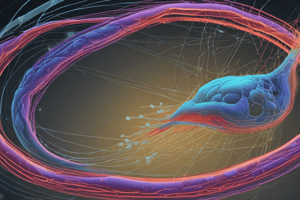Podcast
Questions and Answers
What is the primary function of cartilage?
What is the primary function of cartilage?
- To produce blood cells
- To store nutrients
- To serve as a shock absorber (correct)
- To provide structural support
What surrounds cartilage in most places?
What surrounds cartilage in most places?
- A layer of bone cells
- A layer of muscle tissue
- A layer of adipose tissue
- A sheath of dense connective tissue (correct)
How do chondrocytes receive nutrients?
How do chondrocytes receive nutrients?
- Through passive transport
- By diffusion from capillaries in surrounding connective tissue (correct)
- Through a network of blood vessels
- Through active transport
What type of cartilage is found in the trachea?
What type of cartilage is found in the trachea?
What type of cartilage is found in the auricle of the ear?
What type of cartilage is found in the auricle of the ear?
What type of cartilage is found in a small region of intervertebral disc?
What type of cartilage is found in a small region of intervertebral disc?
What is the main component of bone matrix?
What is the main component of bone matrix?
What type of bone makes up 80% of the total bone mass?
What type of bone makes up 80% of the total bone mass?
What type of bone is characterized by numerous interconnecting cavities?
What type of bone is characterized by numerous interconnecting cavities?
What type of cells are found in cavities (lacunae) between bone matrix layers?
What type of cells are found in cavities (lacunae) between bone matrix layers?
Flashcards are hidden until you start studying
Study Notes
Epithelial Tissue
- Epithelial cells form a tight seal at the apical end, appearing fused or tightly apposed under an electron microscope.
- The zonula occludens (tight junction) forms a seal between adjacent cells.
- The zonula adherens (belt desmosomes) encircles the cell immediately under the tight junction.
- Macula adherens (desmosomes) are disc-shaped structures that match identical structures on adjacent cell surfaces.
- Gap junctions (nexus) facilitate intercellular communication rather than adhesion or occlusion.
Glandular Epithelium
- Glands are groups of cells that synthesize substances for release into the bloodstream or body cavities.
- Types of glands:
- Unicellular glands (e.g., Goblet cells)
- Multicellular glands (e.g., Salivary glands)
- Endocrine glands (e.g., Thyroid, Adrenal glands) with no ducts
- Exocrine glands (e.g., Salivary, Sweat glands) with ducts
- Apocrine glands (e.g., secretion involves cell disintegration)
- Merocrine glands (e.g., secretion via exocytosis)
- Holocrine glands (e.g., entire cell disintegrates as secretion)
- Serous glands
- Mucous glands
- Mixed seromucous glands
Connective Tissue
- Fibrous components of connective tissue are formed from proteins secreted by fibroblasts.
- Main types of fibers:
- Collagen fibers
- Reticular fibers
- Elastic fibers
Epithelial Surface Specializations
- Free or apical surface epithelial cells show projections:
- Microvilli (increase apical surface area for absorption)
- Cilia (move mucous in the lumen)
- Stereocilia (long microvilli for absorption and signal generation)
Lateral Surfaces Specializations
- Intercellular junctions:
- Collagen and reticular fibers
- Elastic fibers
Connective Tissue Fibers
- Collagen fibers:
- Form various extracellular fibers, sheets, and networks
- Extremely strong and resistant to normal shearing and tearing forces
- Represent 30% of the human body's dry weight
- Produced by fibroblasts and other cell types
- Reticular fibers:
- Found in delicate connective tissue of many organs
- Consist mainly of collagen type III
- Form an extensive network for supporting cells
- Invisible in H&E and require silver stain
- Elastic fibers:
- Thinner than collagen fibers
- Form sparse networks interspersed with collagen bundles
- Have rubber-like properties, allowing tissue to be stretched and return to its original shape
The Ground Substance (Matrix)
- A highly hydrated, transparent, complex mixture of:
- Glycosaminoglycans (GAGs)
- Proteoglycans
- Glycoproteins
Mucoid Tissue
- Found in the fetal umbilical cord (Wharton's jelly)
- Gelatinous, with sparse collagen fibers and scattered fibroblasts
- Abundant ground substance composed chiefly of hyaluronan
Adipose Tissue
- White adipose tissue:
- Specialized for long-term energy storage
- Adipocytes are spherical when isolated and polyhedral when closely packed
- Contain single large droplets of triglycerides (unilocular adipocyte)
- Brown adipose tissue:
- Constitutes 2%-5% of newborn body weight
- Found mainly in the back, neck, and shoulders, but reduces during childhood and adolescence
- Contains many small lipid inclusions (multilocular adipocyte)
Specialized Connective Tissue
- Cartilage:
- Consists of cells called chondrocytes embedded in the ECM
- Chondrocytes synthesize and maintain ECM components
- Semi-rigid consistency due to water bound to hyaluronan and GAG chains
- High content of bound water allows cartilage to serve as a shock absorber
- Lacks vascular supplies, with chondrocytes receiving nutrients by diffusion from capillaries in surrounding connective tissue
- Main types of cartilage:
- Hyaline cartilage
- Elastic cartilage
- Fibrocartilage
- Bone:
- A specialized connective tissue composed of calcified extracellular material and three major cell types:
- Osteocytes and osteoblasts
- Osteoclasts (giant, multinucleated cells)
- Types of bone:
- Compact (cortical) bone
- Cancellous bone
- A specialized connective tissue composed of calcified extracellular material and three major cell types:
Studying That Suits You
Use AI to generate personalized quizzes and flashcards to suit your learning preferences.




